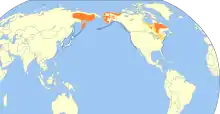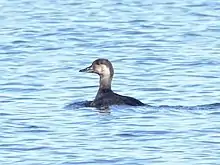Black scoter
The black scoter or American scoter (Melanitta americana) is a large sea duck, 43 to 49 cm (17 to 19 in) in length. The genus name is derived from Ancient Greek melas "black" and netta "duck". The species name is from the Latin for "American ".[2]
| Black scoter | |
|---|---|
 | |
| Adult male | |
| Scientific classification | |
| Domain: | Eukaryota |
| Kingdom: | Animalia |
| Phylum: | Chordata |
| Clade: | Dinosauria |
| Class: | Aves |
| Order: | Anseriformes |
| Family: | Anatidae |
| Genus: | Melanitta |
| Subgenus: | Oidemia |
| Species: | M. americana |
| Binomial name | |
| Melanitta americana (Swainson, 1832) | |
 | |
| Synonyms | |
|
Melanitta nigra americana | |
Together with the common scoter M. nigra, it forms the subgenus Oidemia; the two are sometimes considered conspecific, the black scoter then being referred to as M. nigra americana. Its French name, used in parts of its Canadian range, is macreuse noire (also meaning "black scoter").[3] The species is listed as Near Threatened by the IUCN.
Description
This large sea duck is characterised by its bulky shape and large bill. The adult male is all black with a very bulbous bill which is mostly yellow. The female is a brown bird with pale cheeks, very similar to female common scoter. The adult female averages about 980 g (2.16 lb) and 45 cm (18 in) in length, while the adult male is on average 1,100 g (2.4 lb) and 49 cm (19 in) in length.
This species can be distinguished from other scoters, apart from common scoter, by the lack of white anywhere on the drake, and the more extensive pale areas on the female.
| Standard Measurements[4][5] | |
|---|---|
| length | 430–550 mm (17–21.5 in) |
| weight | 950 g (2.09 lb) |
| wingspan | 710 mm (28 in) |
| wing | 213–233 mm (8.4–9.2 in) |
| tail | 83–97 mm (3.3–3.8 in) |
| culmen | 42–45.5 mm (1.65–1.79 in) |
| tarsus | 45–48.5 mm (1.77–1.91 in) |
Vocalisations
The black scoter and common scoter have diagnosably distinct vocalisations.[6]
Distribution and habitat
The black scoter breeds in the far north of North America in Labrador and Newfoundland to the southeast and northwest of Hudson Bay. It also occurs on the Siberian side of the Bering Straits east of the Yana River. It winters farther south in temperate zones, on the coasts of the northern USA and Canada, on the Pacific coast south to the San Francisco Bay region and on the Atlantic and Gulf of Mexico coasts, and in Asia as far south as China.[3][7]
Some birds may over-winter on the Great Lakes. This species is a very rare vagrant to western Europe; only drakes are safely identifiable out of range, so females are likely to be undetected.
Ecology
This species dives for crustaceans and molluscs while migrating or wintering on the sea-coasts, and feeds on insects and their larvae, especially caddisflies, fish eggs and, more rarely, vegetation such as duck weed while nesting on freshwater. It forms large flocks on suitable coastal waters in winter quarters. These are tightly packed, and the birds tend to take off together; in the breeding season they are less social. It has been suggested that in coastal waters this species prefers sheltered embayments, and possibly waters that include some mixed depths.[8]
Black scoters nest later than most other ducks in North America. Pairs form in late winter or spring. The lined nest is built on the ground close to the sea, lakes or rivers, in woodland or tundra. 5–7 eggs are laid. Each eggs weighs from 60–74 g (2.1–2.6 oz), or 8% of the females body weight. The incubation period may range from 27 to 31 days. Females brood their young extensively for about 3 weeks, after which the still flightless young must fend for themselves.
The male performs a diagnostic downward head movement when stretching his wings.[5]
References
- BirdLife International (2018). "Melanitta americana". IUCN Red List of Threatened Species. 2018: e.T22732425A132662655. doi:10.2305/IUCN.UK.2018-2.RLTS.T22732425A132662655.en. Retrieved 12 November 2021.
- Jobling, James A (2010). The Helm Dictionary of Scientific Bird Names. London: Christopher Helm. pp. 44, 246. ISBN 978-1-4081-2501-4.
- "Black Scoter (Melanitta nigra)". Sea Duck Information Series. Sea Duck Joint Venture. 2003. Retrieved 15 November 2006.
- Godfrey, W. Earl (1966). The Birds of Canada. Ottawa: National Museum of Canada. p. 358.
- Sibley, David Allen (2000). The Sibley Guide to Birds. New York: Knopf. p. 98. ISBN 0-679-45122-6.
- Sangster, George (2009). "Acoustic Differences between the Scoters Melanitta nigra nigra and M. n. americana". The Wilson Journal of Ornithology. 121 (4): 696–702. doi:10.1676/04-088.1. S2CID 59519919.
- Some unusual records for San Mateo County, California. Abstract in: Littlejohn, Chase (1916). "Minutes of Cooper Club Meetings". Condor. 18 (1): 38–40. doi:10.2307/1362896. JSTOR 1362896.
- Deghi, Gary; et al. (1998). Environmental Impact Report for the Pillar Point East Harbor Master Plan (Report). San Mateo County Harbor District: Earth Metrics Inc.
External links
- Black Scoter Species Account and Photo Gallery – Sea Duck Joint Venture
- "Black scoter media". Internet Bird Collection.
- Black scoter photo gallery at VIREO (Drexel University)
- Black Scoter Species Account – Cornell Lab of Ornithology
- Interactive range map of Melanitta americana at IUCN Red List maps

